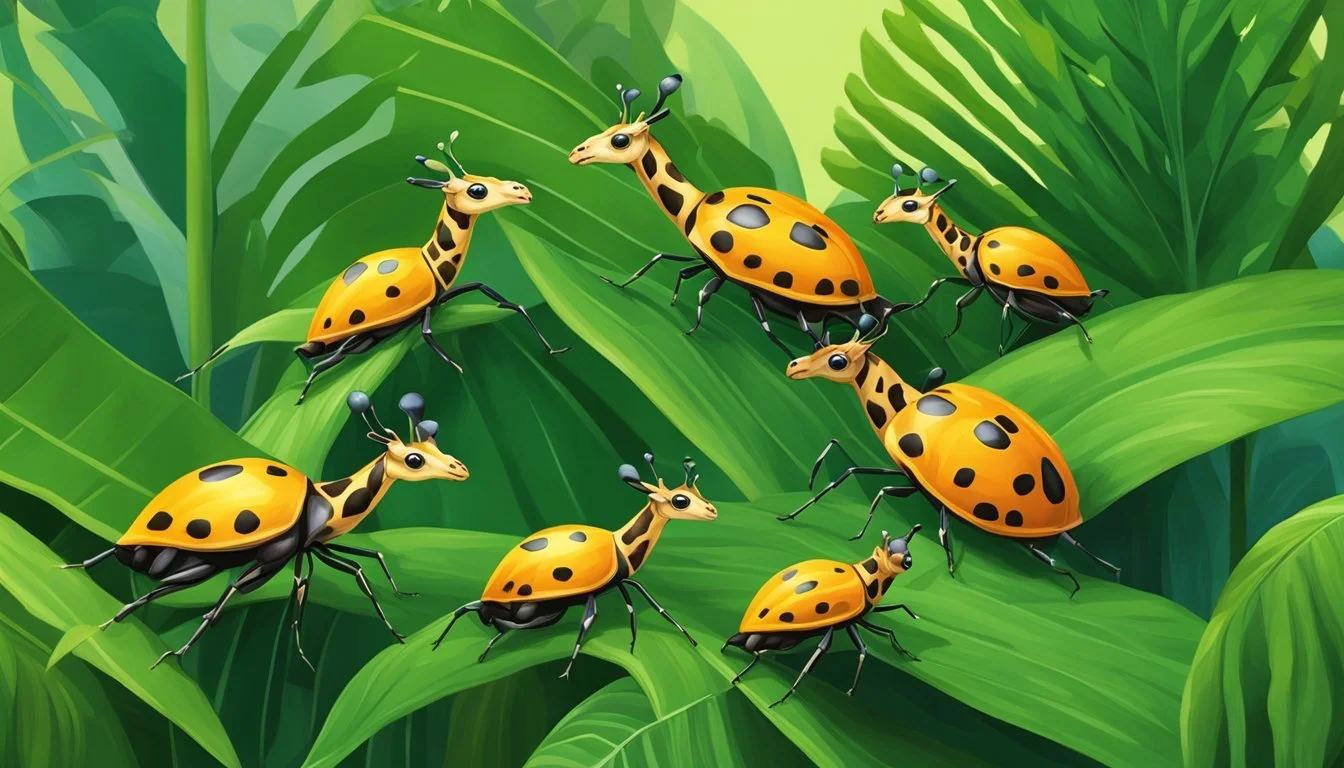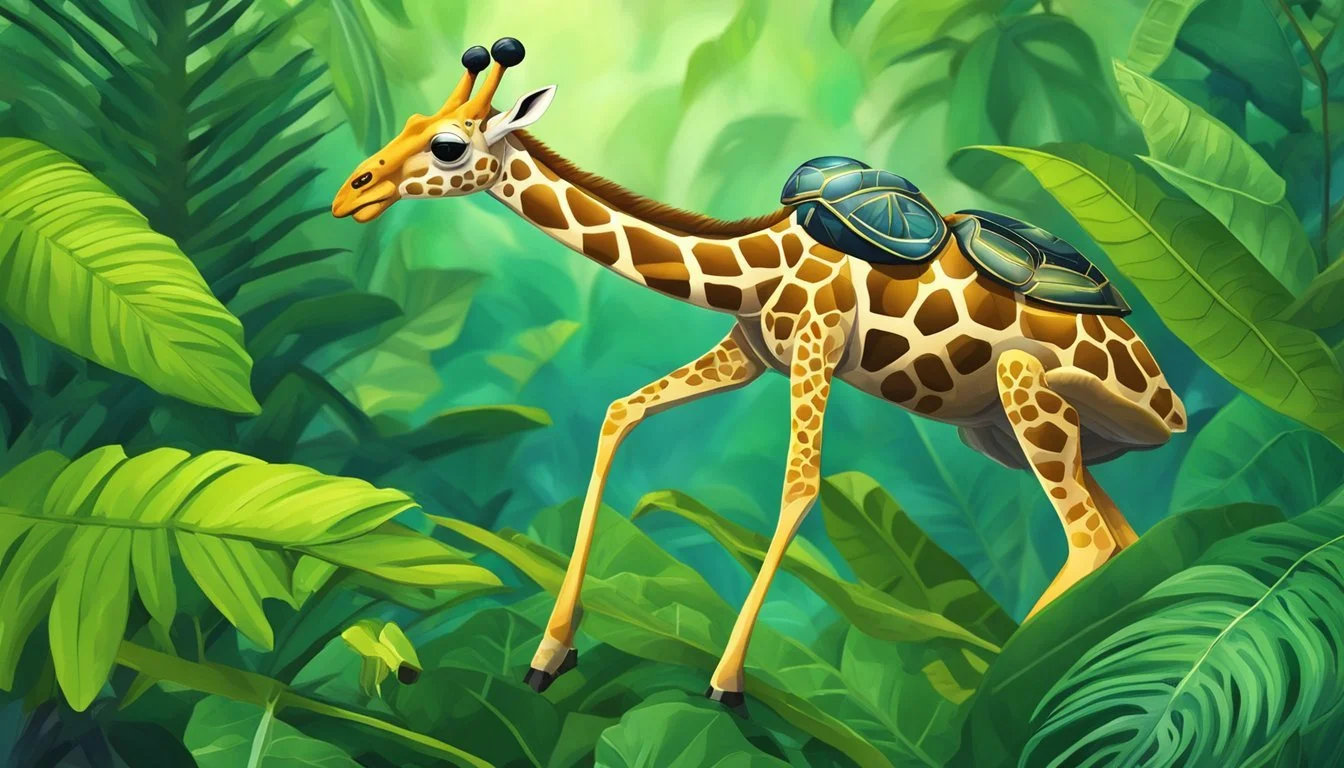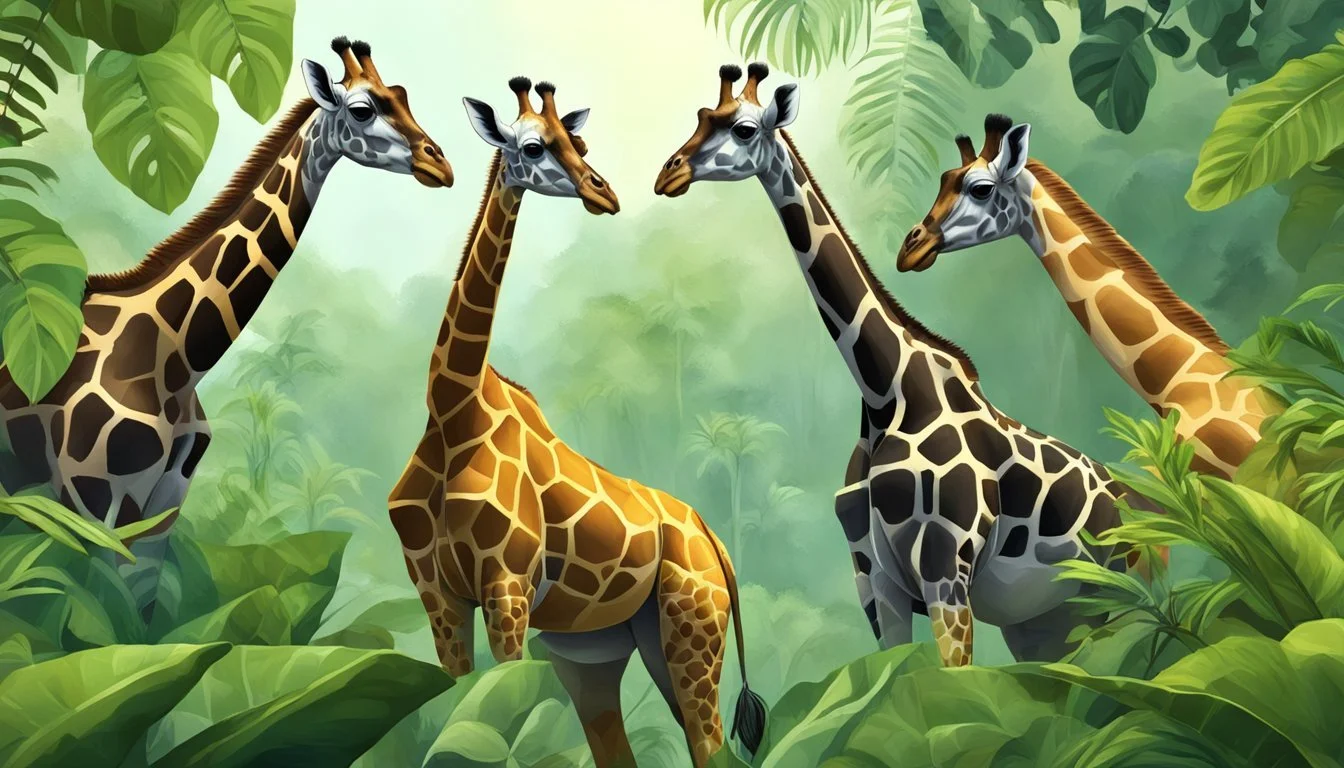Giraffe Beetles
A Unique Glimpse into Madagascar's Entomological Wonders
The giraffe beetle, scientifically known as Trachelophorus giraffa, is one of nature's most architecturally curious creatures. Found exclusively on the lush island of Madagascar, this insect captivates onlookers with its extraordinary elongated neck, which bears a striking resemblance to that of the giraffe. This unique adaptation sets it apart within the diverse weevil family and sparks considerable interest among both scientists and enthusiasts.
Male giraffe beetles, distinguished by their longer necks that can be two to three times the size of their female counterparts, utilize their distinctive morphology for combat and nest building. The differences in neck length are not merely for show but play a critical role in the beetle's life cycle and reproductive success. Notably, the giraffe beetle was formally recognized by science relatively recently, which highlights the insect's rare and elusive status in the broader context of entomology.
Despite their distinctive appearance and fascinating behavior, giraffe beetles are not extensively documented, which can be attributed to the sheer diversity of beetle species in existence. Nevertheless, this lack of comprehensive study adds to the enigma surrounding these insects and underscores the need for further research to fully understand their ecological role and conservation status on an island as biodiverse as Madagascar.
The Majesty of Madagascar's Giraffe Beetles
Amidst Madagascar's unique biodiversity, the giraffe beetle stands out as an insect with remarkable physical traits and an intriguing lifestyle. This section delves into its defining characteristics, where it thrives, and its role in the ecosystem.
Defining Characteristics of Giraffe Beetles
Giraffe beetles, scientifically known as Trachelophorus giraffa, exhibit a distinctive elongated neck, especially prominent in male specimens. Males possess necks that can be 2 to 3 times longer than those of females, showcasing a pronounced example of sexual dimorphism. This feature aids them in nest building and combat with other males. Their bodies are typically black or brown, with males flaunting bright red wing cases, known as elytra, that protect their flying wings.
Habitat and Distribution
Giraffe beetles are endemic to Madagascar, a hotspot for endemic species due to its isolation. They are predominantly found in the rain forests, dry forests, and spiny forest regions surrounding the island. These beetles have an affinity for trees like baobabs and octopus trees, with notable populations in regions like Masoala National Park. Their presence is an indicator of the health of Madagascar's forests and contributes to the island's extensive biodiversity.
Ecological Significance
The behavior of giraffe beetles, particularly in mating and nesting, plays a significant role in the ecology of Madagascar's forests. By constructing nests from leaves, which they then roll and secure using their long necks, they contribute to the tree's life cycle and the overall forest ecology. Additionally, giraffe beetles serve as pollinators and participate in nutrient recycling, emphasizing their contribution to the ecosystem. Despite their fascinating role, the conservation status of giraffe beetles remains unclear, highlighting the need for more research on these unique insects of Madagascar.
Behavioral Aspects of Giraffe Beetles
The Giraffe Beetle, an insect endemic to Madagascar, showcases unique behaviors related to feeding, reproduction, and interaction with other species that are fascinating to observe and study.
Feeding Habits and Diet
Giraffe Beetles primarily feed on the sap of specific trees located throughout Madagascar. Both male and female beetles use their mandibles to bore into the bark, allowing them access to the sap on which they sustain themselves. The larvae are also dependent on this sap, beginning their life cycle feeding on the rich, sugary substance after hatching.
Reproduction and Lifecycle
Reproduction among Giraffe Beetles involves elaborate rituals centered around the construction of elaborate nests. Males use their extended neck to roll and secure leaves, creating a safe environment for the female to lay her eggs. This distinct neck also serves as an advantage when competing males vie for the attention of a potential mate, engaging in neck-fighting battles that determine who gets the opportunity to reproduce.
Interaction With Other Species
Giraffe Beetles coexist with a variety of species in the rich ecosystem of Madagascar. While the larvae may fall prey to leaf-tailed geckos or katydids, adult beetles tend to be less vulnerable due to their size. Moreover, they do not typically interact with lemurs or crickets, as these animals inhabit different niches within the environment. Therefore, Giraffe Beetles continue their existence relatively undisturbed, contributing to the diverse Madagascar habitat.
Anatomical Features and Adaptations
The giraffe beetle of Madagascar showcases intriguing anatomical features and adaptations that are crucial for its survival. These include an unusually long neck, particularly developed mandibles, unique antennae, and specialized forelegs, adapting to maximize their feeding, breeding, and competitive interactions.
The Role of the Long Neck and Mandibles
The most striking feature of the giraffe beetle (Trachelophorus giraffa) is the long neck, which gives the species its name. In males, the neck is 2 to 3 times longer than that of females and serves a dual purpose. Firstly, it helps in foraging by allowing the beetle to reach deeper into crevices and folds of tree bark to extract food. Secondly, it plays a critical role during mating rituals, where competing males will use their elongated necks and strong mandibles to wrestle each other off of trees to win over a female.
Unique Antennae and Forelegs
Giraffe beetles are also equipped with distinct antennae and forelegs. The antennae are used for sensory perception, allowing them to navigate their environment and locate potential mates. Their forelegs have adapted to help them grip onto surfaces, necessary for both climbing and in the case of males, holding onto females during mating.
Sexual Dimorphism and its Function
Giraffe beetles are a prime example of a species exhibiting sexual dimorphism, which is the variation in form between individuals of different sex in the same species. Males boast longer necks and larger mandibles, which they use not only for competing with other males but also for rolling and manipulating leaves to create a nest for female eggs. Females, with relatively shorter necks, are more adept at egg-laying and navigation through the dense foliage of their habitat. This sexual dimorphism enhances the reproductive success of the species.
Conservation Concerns and Human Impact
The Giraffe Beetle, with its elongated neck and distinctive appearance, faces certain threats as a result of human activities, yet conservation efforts and cultural practices offer some protection for this unique insect endemic to Madagascar.
Threats to Giraffe Beetle Populations
Deforestation in Madagascar poses a significant threat to the habitat of the Giraffe Beetle. Land clearing for agriculture and illegal logging reduce their natural environment. As the beetle relies on specific tree species for survival, the loss of these trees directly impacts their population.
Primary causes of deforestation:
Agriculture expansion
Illegal logging
Charcoal production
Conservation Efforts and the Role of Protected Areas
Protected Areas play a crucial role in preserving the habitats of Madagascar's unique species including the Giraffe Beetle. Masoala National Park, one of the nation's protected areas, encompasses diverse ecosystems that are critical for the survival of many endemic species. Conservation initiatives often focus on:
Establishing and managing protected habitats
Engaging local communities in conservation
Cultural Significance and Local Taboos
Cultural traditions and taboos (local term fady) can have a profound effect on conservation. In Madagascar, certain species and areas are often revered or protected due to local beliefs. These cultural practices can inadvertently contribute to the conservation of the Giraffe Beetle and other biodiversity by limiting human exploitation and fostering a protective attitude towards the environment.
Examples of cultural conservation:
Species-specific taboos
Sacred forests
Giraffe Beetles in Science and Education
Giraffe beetles, endemic to Madagascar, provide rich subject matter for entomology and science education. Entomologists study these species to understand their unique biology and role in biodiversity, while their intriguing form and behavior offer engaging themes for educational programs and quizzes.
Research Contributions by Entomologists
Entomologists have made significant strides in unveiling the Trachelophorus giraffe's life cycle and behavior, shedding light on its role in Madagascar's diverse ecosystem. Their long necks, a distinctive evolutionary trait, have piqued the interest of researchers exploring the mechanisms of species adaptation. These studies contribute to a broader understanding of biodiversity on the island.
Educational Opportunities and Public Engagement
Educational resources often incorporate the giraffe beetle to captivate and educate individuals on Madagascar's unique biodiversity. Schools and museums may offer quizzes and interactive displays that highlight the giraffe beetle, providing a gateway for the public to engage with entomology and environmental science. These activities underscore the importance of conservation efforts for such distinctive species.
The Fascination in Popular Culture
The giraffe beetle's unusual appearance has cemented its place in popular culture, often featured in documentaries and science exhibits. This fascination aids in public education about biodiversity and ecosystem importance. By featuring in mainstream media, giraffe beetles serve as charismatic ambassadors for Madagascar's rich yet vulnerable environment.
Comparative Analysis with Other Insects
This section provides a focused comparison of the giraffe weevil with other distinctive insect groups, examining both similarities and contrasts.
Similarities to Rhinoceros and Stag Beetles
Giraffe Beetles share several characteristics with the Rhinoceros Beetle and Stag Beetle. All three belong to the order Coleoptera and are notable for their prominent, exaggerated body parts: the giraffe beetle for its extended neck, and the rhinoceros and stag beetles for their horn-like antlers. These physical adaptations serve as tools for both combat among males and as a method for attracting mates.
Environment: While their habitats vary, they often inhabit regions with dense, woody vegetation, such as the dry forests of Madagascar where giraffe beetles are found.
Body Size: These beetle species exhibit sexual dimorphism, meaning the males typically grow larger than the females. Male giraffe beetles measure between 15-90 mm, while rhinoceros and stag beetles are similarly sized in their respective species.
Contrast with Cockroaches and Crickets
In sharp contrast, giraffe beetles differ significantly from cockroaches and crickets in both behavior and habitat preferences. While giraffe beetles are mainly found in the dry forests of Madagascar, cockroaches and crickets have a global presence, spanning from North America to Australia and India. Cockroaches and crickets are also known for their omnivorous diet and tend to inhabit moist, dark environments whereas giraffe beetles are typically associated with leafy areas and consume plant material.
Reproductive Behavior: Cockroaches and crickets have less pronounced sexual dimorphism compared to giraffe beetles.
Physiology: Neither cockroaches nor crickets exhibit the dramatic elongations found in giraffe beetles; crickets are recognized for their jumping legs, and cockroaches for their speed and resilience.
Global Presence of Beetle Species
Beetle species, in general, have an expansive global reach. The giraffe beetle is endemic to Madagascar, displaying localized adaptation. In comparison, rhinoceros and stag beetles can be found in various locations around the globe, including North America, Australia, and India.
Distribution:
Giraffe Beetle: Endemic to Madagascar.
Rhinoceros Beetle: Found in tropical regions of Asia, Africa, and elsewhere.
Stag Beetle: Distributed across parts of North America, Europe, and Asia.
They are all efficient at exploiting their respective niches, which contributes to the biodiversity and ecological balance within their environments.
Future Directions in Giraffe Beetle Research
Research on the giraffe beetle (Trachelophorus giraffa) holds promise, with potential implications spanning from new biological insights to conservation efforts. The following subsections detail specific areas where research may expand our understanding and aid in the protection of this unique species from Madagascar.
Potential for New Discoveries
Scientists hypothesize that the giraffe beetle's elongated neck and unique behavior could be linked to diverse, unknown biological functions. Detailed taxonomic work could unearth different species within what is currently considered a single species, increasing our understanding of biodiversity within the giraffe beetle’s genus.
Impact of Climate Change
The giraffe beetle's habitat, primarily Madagascar's dry forest, is sensitive to climate fluctuations. Studies focused on the impact of climate change could reveal how altered rainfall and temperature patterns affect their lifecycle and behaviors, such as movement and mating rituals.
Advancements in Beetle Conservation
With deforestation posing a threat to Madagascar's biodiversity, conservation research is critical. Preservation strategies could include:
Habitat conservation plans: Outline actions to protect the dry forest environment.
Community engagement efforts: Mobilize local populations to reinforce conservation.
Integration with Technological Innovations
Modern technology could significantly advance giraffe beetle research:
Tracking movements: GPS and radio telemetry can provide data on beetle migration.
Environmental monitoring: Sensors could yield real-time data on habitat conditions.
These technologies could offer a clearer picture of how human-induced changes, like the introduction of artificial lights or deforestation, impact the giraffe beetle's ecology.





